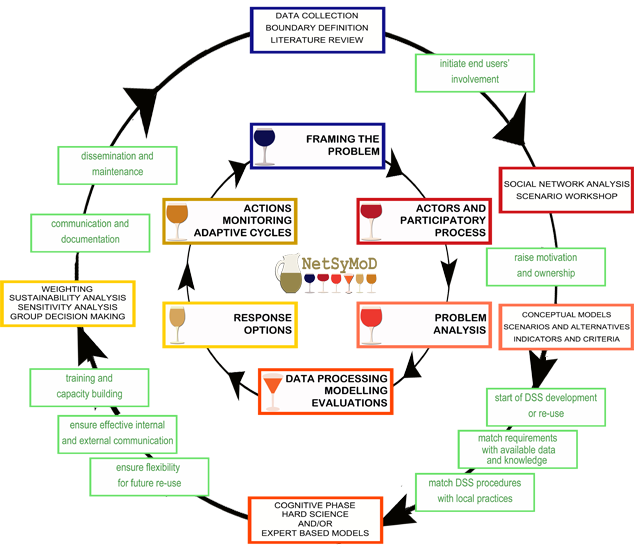NetSyMoD
TT
The NetSyMoD approach (Network Analysis – Creative System
Modelling – Decision Support) is intended to provide a flexible but
comprehensive and operational decision support framework for
facilitating participatory decision making processes (DMPs) in various
fields related to the environment, including climate change adaptation.
In such
context, decision is intended in a broad sense, including any process
in which a choice has to be taken by examining the available
information on a given problem. Typically, the choice consist in the
selection of the preferred alternative within a given set of option.
The problem itself, the information, and the choice are defined with
the contribution of different actors and with two main categories of
applications which may be also encountered together in the same case:
(i) the involvement of experts in a decision or an evaluation of an
environmental problem requiring multiple fields of expertise, and (ii)
the involvement of interested actors in a participatory process dealing
with the management of environmental resources.
The proposed
approach is aimed in particular at facilitating both the integration of
environmental, social, and economic concerns and the involvement of
interested parties in the formulation of strategies and decisions.
A generic DMP is formalised in NetSyMoD as a sequence of six main phases:
• Framing the problem: problem exploration and set up of the decision process and specific objectives
• Actors and participatory process: design and launch of participatory activities
• Problem analysis: formalization of the problem and of the decision process
•
Data processing - Modelling – Evaluation: collection and elaboration of
data and their evaluation according to the defined objectives
• Response options: Analysis of possible solutions to the given problem
•
Actions – Monitoring – Adaptive cycles: implementation of decisions
monitoring of effects and possible revisions and adaptations.

Having identified the decision context (e.g.a river basin management plan), the actors to be involved, and how to deal with main issues, ideas are further elaborated and formalised in dedicated workshop activities, which facilitate collective learning and the building of a shared conceptual model. The latter - usually developed trough cognitive maps, causal loop diagrams or similar - provides the common communication basis, together with the frame for the design of Data Processing, Modelling and Evaluation procedures. As proposed in NetSyMoD, these initial steps are also intended to provide solid bases for the development of a dedicated Decision Support System (DSS). The DSS here plays a fundamental role as a means to facilitating the integration of scientific knowledge and participatory approaches, and for providing end users with efficient methods and tools for the management of the process leading to the identification of the preferred Response Options and eventually to the implementation of the courses of action in the final step of Actions – Monitoring – Adaptive cycle. The implementation of the courses of action foreseen by the selected option and the monitoring of their effectiveness, may then initiate subsequent iteration and adaptations.
The NetSyMoD approach is made operational via the adoption of a suite of methods and tools that can be used depending on circumstances to put in place a logical sequence of steps (see figure below).
A specific emphasis is put on the role of ICT (Information and Communication Technology) tools freely downloadable from the internet as means to facilitate dissemination of scientific methods and improvement of current decision making practices. NetSyMoD is targeted to contribute to the adoption of improved Decision Support System (DSS) and state-of-the-art approaches in the field of modelling: from the more consolidated approaches making use of disciplinary mathematical models, to the more innovative creative approaches for integrated participatory modelling.
The participatory approach allows that the problem itself, the information needs and management, and the choice itself are defined with the contribution of different actors (stakeholders, experts). Building a decision support system tool in a participatory way improves the performance of the tool, increases its acceptability, and, ultimately, the acceptability of the decisions taken with its support.
Several variants of the NetSyMoD approach have been applied so far in different context: integrated water resources management, climate change adaptation, agri-environmental policy, coastal management, etc.





